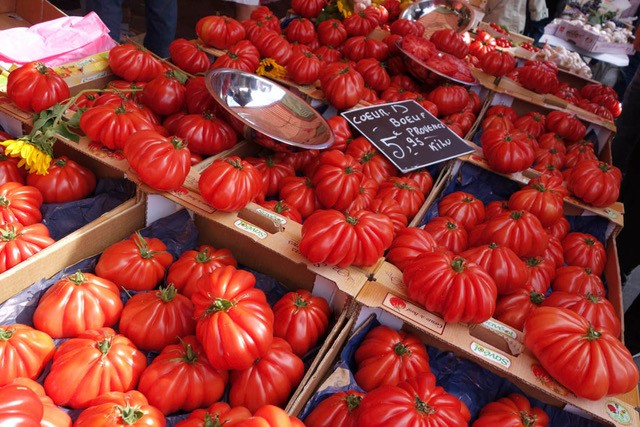Published in French Provincial
Kale, chickpeas and olive oil. This food sounds too healthy to be on a food tour, but as Al, our guide on A Taste of Nice explains, “the diet is accidentally filled with superfoods”. Luckily he assures us that, being France, there’s a fair measure of wine, chocolate and pastries too.
The website warns us to come hungry and as soon as we get to our meeting point I can see (and taste) why.
We start with a slice of sweet fougasse, a type of focaccia. He asks us to guess the secret ingredient, which turns out to be orange blossom, giving it a piquant, slightly sweet tang.
According to Al, the Niçoise get their food influences from the French, Arabs, Greeks, Italians and Turks. Unlike classic French fare, Niçoise cuisine traditionally does not contain butter or cheese and usually there is very little meat. Instead it is a true Mediterranean diet based on seafood, goats’ cheese, fruit and plenty of vegetables.

He guides us in the direction of Queen Victoria’s favourite chocolate shop, Maison Auer. The queen spent many summers in Nice, kick starting the English tourism boom of the French Riviera, which later led to the construction of the celebrated Promenade des Anglais. During her many visits Queen Victoria usually visited Maison Auer. This chocolate shop and confectioners was started by young Swiss confectioner, Henri Auer, in 1820 and today his family still make traditional candied fruit and artisan chocolates. We try their hand-crafted delicacies like cacao-coated almonds and candied angelica, a celery-like vegetable, which in their hands tastes delicious.
After our sugar hit, we head to the old town, a labyrinthine tangle of 15th and 16th century streets. As we weave through crooked laneways, Al intersperses a little history into our foodie walk and I’m interested to learn that Nice is named after the Greek Goddess of Victory, Nike, and that the city has traded hands many times over the years, finally becoming a French territory in 1860.
We walk past the oh-so-photogenic flower market (a Rick Steves fave) to the best wine shop in the world. Here Al tests the theory that wine is cheaper than water. He gives a volunteer some money and asks her to pop into the tabac and buy the cheapest litre of water and give the receipt to Al. Then we enter an old-fashioned wine bar where another volunteer asks for a litre of wine and again gives the receipt to Al. The proprietor turns to a tap behind the bar and fills it with vin ordinaire. Then Al compares receipts. The verdict? Water is still cheaper than wine – but only by 5 centimes.
These types of shops for filling up wine were the norm 50 or 60 years ago but are now increasingly rare. Al tells us that many of the local restaurateurs get their wine this way. We try it and it is not bad (Pays du Var), especially for 2.05 Euros a litre. My kind of Evian!
As we wend our way through the alleyways, we pass a pasta shop. Italy’s influence in Nice is strong, from bronzed locals to citrus-coloured buildings and extravagant architecture.
On display is pale green pasta labelled “Merda di Can”, which in traditional dialect translates to “dog poo pasta”. Al explains it is made from kale, the hip new super food on everyone’s lips.
Think Niçoise cuisine, think Niçoise Salad, which was popularised by American TV chef, Julia Childs. However Al shows there is much more to local cuisine and introduces us to socca, the local fast food. Socca is a type of crispy pancake made from chickpea flour, water, salt and olive oil, then doused in pepper and deep fried.
After one bite, it’s a mystery to me how this has not caught on in the rest of the world. It’s crunchy, satisfying, fragrant and hot – the perfect street food.
Al has put a lot of thought into showing visitors the most authentic side of French Riviera cuisine. He takes us on the electric tram to the best socca shop in town. Then we go to a café to try the local version of tapas, known as Les Petits Farcis, literally “the little stuffed ones”. These are baked vegetables filled with a mixture of breadcrumbs, garlic and oil, proving again that Riviera cuisine is both delicious and healthy.
Then it is time to tour the markets.
Al has lived and worked all over the world, but he believes France has the best markets in the world. “It is because we do not have a farmers market”, he says, “it is taken as a given”.
We survey mushrooms, pumpkins and local Nice tomatoes with distinctive striated lines.
We stop at a cheese shop for unpasteurised goats’ cheese, illegal in Australia. This seven-day old cheese comes from local farmer, Marie, who owns 60 goats in the hills surrounding Nice. I relish the opportunity to taste something I can’t get back home; it’s a surprisingly mild taste with a thick, butter-like consistency.
French wine and we sample basil infused olive oil as well as passionfruit olive oil – divine!
By now I’m full but find room for one last treat when Al stops at a slot- in-the-wall artisanal glacerie. I try a strangely delicious gelato with carrot, lemon and orange. It’s a refreshing end to the trip and I step out into the streets of Nice feeling full of French Riviera superfoods
